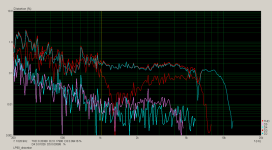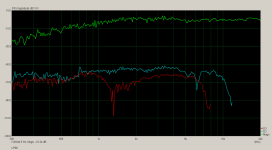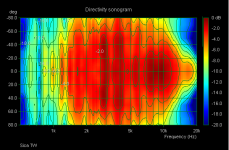Yes understand, and dont know if the dist is from "good" or "bad" harmonics.Well, our ears can live with quite some HD, certainly the even ones. So I think it depends, but a lot of people wouldn’t know the difference.
Its the Sica LP 90.28/N92 TW i maby are little interested in.
https://www.dibirama.it/home-page/tweeter/377-sica-lp90-28-n92-tw-tweeter-1-1-8-ohm-120-wmax.html
If accurate and the SPL for the distortion test is referenced to 1 meter, it's more distortion than I would want. You're basically in the direct radiator sensitivity range. You should be able to find a waveguided tweeter with much lower distortion than that and more output.
If it was a horn-loaded compression driver with much higher sensitivity, it would be more understandable.
Is that distortion data provided by the manufacturer or a third party? It's not easy to take accurate distortion measurements in a home environment, and that graph looks very smooth. Makes me suspicious of the numbers.
If it was a horn-loaded compression driver with much higher sensitivity, it would be more understandable.
Is that distortion data provided by the manufacturer or a third party? It's not easy to take accurate distortion measurements in a home environment, and that graph looks very smooth. Makes me suspicious of the numbers.
The Zaph tweeter mishmash has a lot of data for many tweeters. It's a little dated at this point, but gives a good idea what a typical dome's distortion profile looks like.
http://www.zaphaudio.com/tweetermishmash/
http://www.zaphaudio.com/tweetermishmash/compare.html
http://www.zaphaudio.com/tweetermishmash/
http://www.zaphaudio.com/tweetermishmash/compare.html
I wouldn't make any "acceptability" statements about distortion without knowing the test measurement distance, your expected listening distance, and desired SPL at that distance.
Which harmonics do you consider "good" ? 😉Yes understand, and dont know if the dist is from "good" or "bad" harmonics.
Im bad at interpret this type of measurements, but this is from a guy in Czech RepublicThe Zaph tweeter mishmash has a lot of data for many tweeters. It's a little dated at this point, but gives a good idea what a typical dome's distortion profile looks like.
dimensions of the board approximately 38cm x 23cm. In height, the converter is placed in the middle and 8 cm from the top edge. Rounding around the perimeter 2.5cm
Attachments
Hahaha, all that make my ear´s dance and not to wrinkle oneself 😉 🥳Which harmonics do you consider "good" ? 😉
That's more like what I would expect. The levels and the character seem more typical of a dome tweeter.this is from a guy in Czech Republic

Some more measurements of this tweeter on the german hifi-selbstbau site, including distortion measurement (scroll down to "klirrfaktor" or click here):
https://www.hifi-selbstbau.de/index.php/hsb-datenblaetter/hocht/lp9028n92tw-z009160
https://www.hifi-selbstbau.de/index.php/hsb-datenblaetter/hocht/lp9028n92tw-z009160
Dibirama's distortion measurements can only be compared with dibirama's.
Zaph's can only be compared with Zaphs.
The distortion measured depends on the equipment that is used- that is- it's a measurement of the whole signal chain, including the microphone-
Reference:
Difference microphones have their differing amounts of self noise and distortion
Zaph's can only be compared with Zaphs.
The distortion measured depends on the equipment that is used- that is- it's a measurement of the whole signal chain, including the microphone-
Reference:
Difference microphones have their differing amounts of self noise and distortion
Thank you for link´sSome more measurements of this tweeter on the german hifi-selbstbau site, including distortion measurement (scroll down to "klirrfaktor" or click here):
That is the older version of the tweeter, but don´t know if the newer one just had the X over the cone gone, or if had small changes inside also.
Maby worthy a diy in the future!
Might I ask what distance the distortion measurements in the bottom graph were taken at? The level of distortion seems excessive and it might even be the gain structure introducing distortion in the signal chain.
I suggest using less smoothing and maybe plotting the individual harmonics for comparison against the fundamental.
Measurements are from Dibirama Italy, a serious, recognized talented group of hifi lovers.Might I ask what distance the distortion measurements in the bottom graph were taken at?
Don´t know their measurement (technical terms)
https://www.dibirama.it/home-page/tweeter/377-sica-lp90-28-n92-tw-tweeter-1-1-8-ohm-120-wmax.html
The tweeter for sale was a pair of LP 90 new in box for about 45% of "regular price"Maybe consider the LP110.28 instead.
It is used in Gold Note and Xavian speakers.
- Home
- Loudspeakers
- Multi-Way
- Is this distortion acceptable on a 93 dB tweeter?



